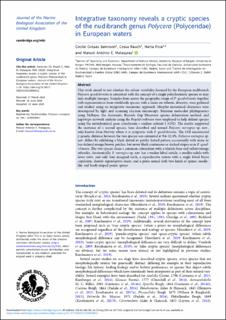| dc.contributor.author | Sørensen, Cecilie Gotaas | |
| dc.contributor.author | Rauch, Cessa | |
| dc.contributor.author | Pola, Marta | |
| dc.contributor.author | Malaquias, Manuel Antonio E. | |
| dc.date.accessioned | 2021-07-14T12:14:53Z | |
| dc.date.available | 2021-07-14T12:14:53Z | |
| dc.date.created | 2021-01-11T13:42:03Z | |
| dc.date.issued | 2020 | |
| dc.identifier.issn | 0025-3154 | |
| dc.identifier.uri | https://hdl.handle.net/11250/2764423 | |
| dc.description.abstract | This work aimed to test whether the colour variability featured by the European nudibranch Polycera quadrilineata is consistent with the concept of a single polychromatic species or may hide multiple lineages. Samples from across the geographic range of P. quadrilineata together with representatives from worldwide species with a focus on Atlantic diversity, were gathered and studied using an integrative taxonomic approach. Morpho-anatomical characters were investigated by light and scanning electron microscopy. Bayesian molecular phylogenetics using MrBayes, the Automatic Barcode Gap Discovery species delimitation method, and haplotype network analysis using the PopArt software were employed to help delimit species using the mitochondrial gene cytochrome c oxidase subunit I (COI). The results supported the existence of a second species, here described and named Polycera norvegica sp. nov., only known from Norway where it is sympatric with P. quadrilineata. The COI uncorrected p-genetic distance between the two species was estimated at 9.6–12.4%. Polycera norvegica sp. nov. differs by exhibiting a black dotted or patchy dotted pattern occasionally with more or less defined orange/brown patches, but never black continuous or dashed stripes as in P. quadrilineata. The two species share a common colouration with a whitish base and yellow/orange tubercles. Anatomically, P. norvegica sp. nov. has a weaker labial cuticle, a smaller radula with fewer rows, and only four marginal teeth, a reproductive system with a single lobed bursa copulatrix, shorter reproductive ducts, and a penis armed with two kinds of spines: needle-like and hook-shaped penile spines. | en_US |
| dc.language.iso | eng | en_US |
| dc.publisher | Cambridge University Press | en_US |
| dc.rights | Navngivelse 4.0 Internasjonal | * |
| dc.rights.uri | http://creativecommons.org/licenses/by/4.0/deed.no | * |
| dc.title | Integrative taxonomy reveals a cryptic species of the nudibranch genus Polycera (Polyceridae) in European waters | en_US |
| dc.type | Journal article | en_US |
| dc.type | Peer reviewed | en_US |
| dc.description.version | publishedVersion | en_US |
| dc.rights.holder | Copyright Marine Biological Association of the United Kingdom 2020 | en_US |
| cristin.ispublished | true | |
| cristin.fulltext | original | |
| cristin.qualitycode | 1 | |
| dc.identifier.doi | 10.1017/S0025315420000612 | |
| dc.identifier.cristin | 1869025 | |
| dc.source.journal | Journal of the Marine Biological Association of the United Kingdom | en_US |
| dc.source.pagenumber | 733-752 | en_US |
| dc.identifier.citation | Journal of the Marine Biological Association of the United Kingdom. 2020, 100 (5), 733-752. | en_US |
| dc.source.volume | 100 | en_US |
| dc.source.issue | 5 | en_US |

